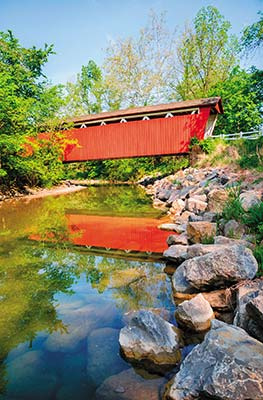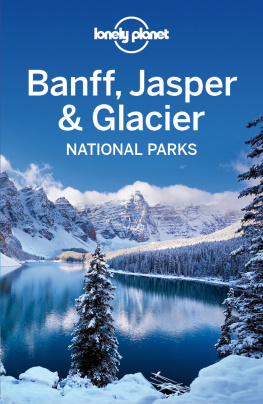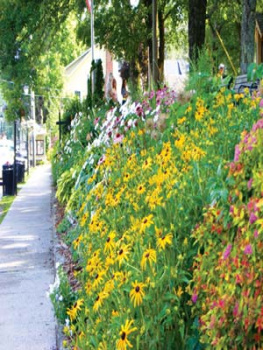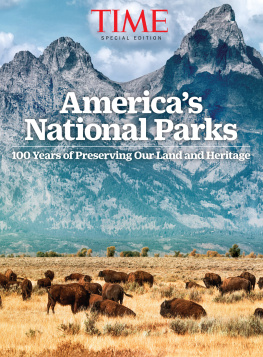The waterhole immediately below Addos main camp (top) offers unmatched opportunities for viewing elephants at close quarters. Towering cliffs of quartzite rise above Marakeles wooded valleys (above).
This book would not have been possible without the assistance of SANParks. Directors Paul Daphne and Hector Magome enthusiastically supported the project and responded to hundreds of queries. Many other park managers provided important information on their parks, and I wish particularly to thank the following people: Peter Bradshaw, Peter Burdett, Deon Joubert, Michael Knight, Obed Maluwa, Andre Riley, Joep Stevens, Megan Taplin, Bernardt and Elanza van Lenter and Robin Wood.
References
Carruthers, J. 1995. The Kruger National Park A Social and Political History. Pietermaritzburg: University of Natal Press.
Carruthers, J. 1997. Nationhood and national parks: Comparative examples from the post-imperial experience. In: Griffiths, T. and Robin, L. (eds). Ecology and Empire: Environmental Histories of Settler Societies. Pietermaritzburg: University of Natal Press.
Mills, G. and Haagner, C. 1989. Guide to the Kalahari Gemsbok National Park. Johannesburg: Southern.
Paterson, W. 1789. A Narrative of Four Journeys into the Country of the Hottentots, and Caffraria: In the Years 1777, 8 and 9. 2nd edition. Printed for J. Johnson.
Pretorius, P.J. 1948. Jungle Man: The Autobiography of Major P.J. Pretorius. London: Alexander Books.
Pringle, J. 1982. The Conservationists and the Killers. Cape Town: TV Bulpin.
First published in 2010 by Struik Travel & Heritage
(an imprint of Random House Struik (Pty) Ltd)
Company Reg. No. 1966/003153/07
Wembley Square, First Floor, Solan Road, Gardens, Cape Town, 8001, South Africa
PO Box 1144, Cape Town, 8000, South Africa
www.randomstruik.co.za
Copyright in published edition: Random House Struik 2010
Copyright in text: Michael Brett 2010
Copyright in maps: Michael Brett 2010
Copyright in photographs: Michael Brett 2010, except where otherwise indicated
Also available in Afrikaans as Reis deur Suid-Afrika se
Nasionale Parke (ISBN 9781770078093 (Print) 9781920545161 (ePub) 9781920545178 (PDF))
Publisher: Claudia Dos Santos
Managing editor: Roelien Theron
Project coordinator: Alana Bolligelo
Editor: Leah van Deventer
Designer: Catherine Coetzer
Proofreader: Sandra Cattich
Cartographic assistants: Andrew and Matthew Brett
ISBN 9781770077645 (Print)
ISBN 9781920545147 (ePub)
ISBN 9781920545154 (PDF)
All rights reserved. No part of this publication may be reproduced, stored in a retrieval system or transmitted, in any form or by any means, electronic, mechanical, photocopying, recording or otherwise, without the prior written permission of the publishers and the copyright holder(s).
While every effort has been made to ensure that the information in this book was correct at the time of going to press, some details might since have changed. The authors and publishers accept no responsibility for any consequences, loss, injury, damage or inconvenience sustained by any person using this book. Please email any comments or updates to:
Front cover (main): Camel thorn groves, Mokala NP.
Front cover (bottom left to right): Touw River, Garden Route NP; leopard, Kruger NP; Cape mountain zebra, Mountain Zebra NP; and Storms River Mouth, Garden Route NP.
Back cover (top): Kelp gull, Caspian tern and curlew sandpiper, West Coast NP.
Back cover (bottom): White rhino, Marakele NP.
Title page: Buffalo, Kruger NP.
Foreword
Dr David Mabunda,
Chief Executive Officer,
South African National Parks
Since the worlds first national park was established in 1872 these protected areas have developed a place in the psyche of human societies, not only as irreplaceable examples of biodiversity, but as symbols of nationhood.
Globally, national parks are the responsibility of national governments and are managed by highly competent conservation authorities. Since South Africas first national park was established in 1926, South African National Parks (SANParks) has expanded park quantity and sizes to meet the state mandate of conserving ecologically sustainable and representative samples of the countrys biodiversity and landscapes.
Park expansion has been particularly rapid since 1994, as funds allocated by the government and donors have allowed for the acquisition of some 930 000 hectares, a considerable 30 percent increase in national park estate. These additions, which include the proclamation of eight new national parks, represent the most significant increase in size of land held for conservation since 1931. SANParks currently manages 19 national parks, conserving 4 million hectares, or 3,3 percent, of the countrys terrestrial surface. SANParks is also directly involved with the implementation of Transfrontier Conservation Areas (TFCAs), one of the most exciting and ambitious conservation projects in the world. Since 2000, the idea of protected areas that straddle national borders has gathered momentum and to date four transfrontier parks have been successfully established, two of which exceed 3,5 million hectares each. Close co-operation and the forging of partnerships between South Africa and her neighbouring countries will ensure effective ecological management of these vast ecosystems and secure their position as premier international ecotourism destinations.
SANParks relies on both state and public support for these national assets to continue thriving. If conservation and its associated cultural values are endorsed, the continued expansion of the countrys national parks will be achievable. Ecotourism and public awareness programmes are thus central to the long-term survival of the national park system.
The People and Conservation Division at SAN-Parks is responsible for many community-based conservation projects aimed at strengthening relationships between SANParks and neighbouring communities, one such project being the annual South African National Parks Week, when park entrance is free.
In line with the ideals of the Rainbow Nation, SANParks is pursuing the vision of making national parks the pride and joy of all South Africans. The holistic concept of people and parks is based on the belief that national parks are for all people, including those who live around them, and that they should be managed as such.
We will continue to offer the citizens of South Africa, and the global community, a system of national parks that combines an unrivalled spectrum of landscape, habitat, vegetation and mammal, bird, reptile and fish species with an exceptional range of accommodation and outdoor recreation options.
Dr David Mabunda
Chief Executive Officer of SANParks
Introduction
It has been called the best idea ever to come out of the United States. In 1870, the Surveyor General of Montana, Henry Washburn, led a group to explore the upper reaches of the Yellowstone River in Wyoming. One night as they sat around the fire, a member of the party, Judge Cornelius Hedges, suggested that the federal government should permanently set aside the Yellowstone region for the good of the nation. The idea was enthusiastically received and quickly moved through the official channels, and on 1 March 1872 President Ulysses Grant signed a bill establishing the worlds first national park. Others followed, and these initial parks of the country, to quote Jane Carruthers, crystallized the romantic settler frontier experience which had brought within the fold of a self-conscious new nation some of the earths most spectacular and monumental scenery (Carruthers, 1997).












